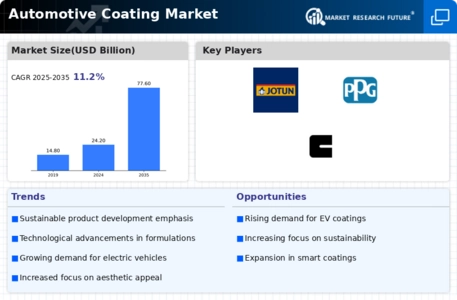Major market players are spending a lot of money on R&D to increase their product lines, which will help the Automotive Coating market grow even more. Market participants are also taking a range of strategic initiatives to grow their worldwide footprint, with key market developments such as new product launches, contractual agreements, mergers and acquisitions, increased investments, and collaboration with other organizations. Competitors in the Automotive Coating industry must offer cost-effective items to expand and survive in an increasingly competitive and rising market environment.
The major market players are investing a lot of money in R&D to expand their product lines, which will spur further market growth for Automotive Coating. With significant market development like new product releases, contractual agreements, mergers and acquisitions, increased investments, and collaboration with other organizations, market participants are also undertaking various strategic activities to expand their global presence. To grow and thrive in a market climate that is becoming more competitive and growing, competitors in the Automotive Coating industry must offer affordable products.
Manufacturing locally to cut operating costs is one of the main business tactics manufacturers use in the global Automotive Coating industry to benefit customers and expand the market sector. The Low-Profile Additives market has recently given medicine some of the most important advantages. Major Automotive Coating market players, including BASF SE (Germany), Axalta Coating Systems (U.S.), Kansai Paint Co., Ltd. (Japan), Akzo Nobel N.V. (Netherlands), and others, are attempting to increase market demand by funding R&D initiatives.
BASF is a company that provides petrochemicals, intermediates, performance materials, monomers, dispersions and pigments, performance chemicals, catalysts, coatings, and care chemicals. It conducts its operations through six business segments: Chemicals, Materials, Industrial Solutions, Surface Technologies, Nutrition and Care, and Agricultural Solutions.
Also, AkzoNobel is a company that manufactures paints and coatings. It offers products such as decorative paints, automotive, specialty, marine, protective, yacht, industrial, and powder coatings. The company operates several brands, such as AkzoNobel, Alabastine, Alba, Apla, Cetol, Coral, Dulux, Flexa, Glitsa, Herbol, and Lesonal.
In 2023, DuPont declared that the major building materials show in Taiwan, Taipei Building Show, will include a number of new products from Coryor Surface Treatment Company Ltd. and Nippon Paint Taiwan, including printed Tedlar® PVF solutions and PVF coating. DuPont and Coryor Surface Treatment Co. collaborated closely to introduce the printed PVF film solutions that were showcased during the exhibition.
In 2024, AkzoNobel declared that it has created a new dark gray, conductive 2K solvent-borne primer for OEM manufacture of plastic parts, which are becoming more and more difficult for automakers to adhere to. Low surface energy and poor adhesion are caused by low polarity plastics, including polypropylene, which makes coating plastic components like bumpers, rocker panels, and contrasting features difficult.



 Source: Secondary Research, Primary Research, Market Research Future Database, and Analyst Review
Source: Secondary Research, Primary Research, Market Research Future Database, and Analyst Review













Leave a Comment